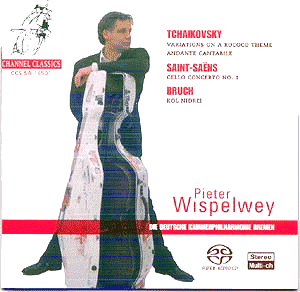 |
Camille
SAINT-SAËNS (1835-1921)
Cello Concerto no. 1 in a minor op.33 (1873)
Pyotr Il'yich TCHAIKOVSKY (1840-1893)
Andante Cantabile
Variations on a Rococo Theme op.33 (1876)
Max BRUCH (1838-1920)
Kol Nidrei op.47 (1881)
 Pieter Wispelwey,
cello Pieter Wispelwey,
cello
Die Deutsche Kammerphilharmonie Bremen/Daniel Sepec, leader
Recorded June 2000
 CHANNEL CLASSICS CCS SA
16501 [55.31] CHANNEL CLASSICS CCS SA
16501 [55.31]
|
| Channel
Classics |
First things first. These are fresh, lithe and lean studio performances of old favourites, given by a fine Dutch cellist with an alert conductor-less Bremen chamber orchestra. Most arresting is the Saint-Saëns, freed from the overblown dramatic intensity familiar from performances by some 'big' cello virtuosi. The outer movements, (all three played without break) are separated by an archaic 'escaped minuet', to quote Wispelwey's intelligent notes; the finale is an expanded version of the first. Balance is good, the cello a little more forward than it would generally be in concert. Good impressions are maintained in all the other items, the rococo variations light as befits a tribute to Mozart, the Bruch melody soulful and involving.
But you may need to play the CD on a normal player, as I did. For up-to-date Hi-Fi enthusiasts there are extras, allegedly technological marvels. It is a Super Audio CD (SACD) release, which allows you to choose from Direct Stream Digital multichannel surround sound, Direct Stream Digital two-channel stereo or, for us old-timers, CD standard stereo.
All is explained on the Channel Classics website, where you can here the cellist give a 4.5 min interview http://www.channelclassics.com. If I can make an opportunity to test out those wonders, I will provide an update addendum. Meanwhile, do not hesitate; this is a CD which will give lasting pleasure.
Peter Grahame Woolf
Addendum:
I have now been able to re-listen to this CD in
various other formats. I do not have a Super Audio CD (SACD) machine
for multichannel sound with multichannel amplifiers (how many non-professional
readers have them, or contemplate purchasing these latest alleged
technical marvel?) but I have been able to re-assess this recording
via a new wide-screen Japanese TV, which I had needed to purchase
in order to be able to See & Hear properly Universal's
NTSC DVDs which can only be played on "PAL/NTSC compatible
(dual-standard)" DVD machines and TVs (see the explanation
in my review of the Gheorghiu/Solti Traviata)
With five speakers, and control of various patterns
of 'surround sound', there are innumerable sonic possibilities.
Suffice to say that the CD sounded great when reviewed previously
in normal stereo (in the past I have generally cross checked between
two systems) and that it sounds even better through my new set-up.
I am finding with pleasure in some of my CDs that the emotional,
feeling content is enhanced.
We have been persuaded to replace our LPs with
CD re-releases, which are certainly more convenient, often sound
better but carry the disadvantage that the liner notes may be skimpier
and can be testing for less than perfect, youthful eyesight.
We may now be entering another new phase of 'planned
obsolescence', with releases of DVD audio titles claiming enhanced
sound quality, and these need to be evaluated with some caution,
and with constant awareness that all domestic assessments of sound
quality are bound to be highly subjective and to depend upon apparatus
and listening environment.
Peter Grahame Woolf
|
|

